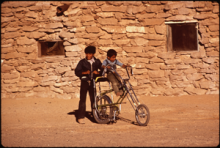Article
The Hopi have lived in the U.S. Southwest for thousands of years, and while their ancestral lands span large swaths of the Southwest, the Hopi Reservation currently covers 1.5 million acres of northeastern Arizona. Within this tract of land there are twelve villages and three mesas. The Hopi Reservation is situated within the Navajo Nation Reservation, a relationship that has caused conflict for over 100 years, as a number of land disputes has resulted in the decrease in size of Hopi land and the creation of a shared Joint-Use territory. While a majority of the Hopi live on three mesas, First, Second, and Third Mesas, there is a Hopi farming community near Tuba City, established in the 1870’s.
Hopi lands first came under control of the U.S. government in 1848 at the end of the Mexican-American War. The war ended with the signing of the Treaty of Guadalupe Hidalgo, where Mexico ceded the southwest, Wyoming, and California to the United States of America. As the Hopi historically avoided interaction with the U.S. government and have always attempted to maintain privacy and sovereignty, the boundary of the Hopi reservation was not determined until 1882. The 1882 U.S. Executive Order-Hopi Indian Reservation originally allotted 2.4 million acres of land to the Hopi. However, this is only a fraction the original 15-million-acre Hopi Tutskwa, or aboriginal Hopi lands. Additionally, when the boundary was drawn, it exclude a large portion of the historic tribal land on which sacred sites, shrines, and villages existed. Later, Hopi reservation land was further reduced in size to 1.5 million acres. The current Hopi tribal lands include the main reservation, the Moenkopi District Reservation, and the Hopi Three Canyon Ranch Lands.
"Hopi Indian Reservation, Coconino county, Arizona, May 1972" by Terry Eiler, for the Environmental Agency, is licensed under Public Domain.
Manuscripts
References
Clemmer, Richard O.
1995 Roads In The Sky: The Hopi Indians In A Century Of Change. Conflict And Social
Change Series. Boulder, Colo.: Westview Press.
Brew, John Otis
1979 Hopi Prehistory And History To 1850. Handbook Of North American Indians.
Washington, D. C.: Smithsonian Institution.
Clemmer, Richard O.
1979 Hopi History, 1940-1974. Handbook Of North American Indians. Washington, D. C.:
Smithsonian Institution.
Courlander, Harold
1987 Fourth World Of The Hopis. Albuquerque: University of New Mexico Press.
Ellis, Florence Hawley
1974 Hopi: Their History And Use Of Lands. Hopi Indians, Compiled And. New York:
Garland Publishing, Inc.
Hieb, Louis A.
1979 Hopi World View. Handbook Of North American Indians. Southwest. Washington,
D. C.: Smithsonian Institution.
McIntire, Elliot Gregor
1988 Impact Of Cultural Change On The Land Use Patterns Of The Hopi Indians. Ann
Arbor, Michigan.

